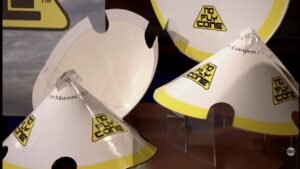Let’s bust a Shark Tank myth right out the gate—getting on national TV isn’t a golden ticket. Tremont Electric proved it. When founder Aaron LeMieux and his nPower PEG walked onto that iconic rug in Season 4, every hustler watching perked up. Why? LeMieux pitched not just a product, but a claim to the future of personal energy. He wasn’t just pushing a gadget; he was out to jumpstart a new chapter in how humans charge up their lives. The room buzzed. This was more than a sales pitch—it was a challenge to the old guard.
Contents
Toggle2. The Spark Behind nPower PEG
So, what exactly was Tremont Electric’s hook? The nPower PEG (Personal Energy Generator), a handheld device that turns your movement into electricity. If you’ve hiked, camped, or ever run out of juice in the middle of nowhere, this idea sounds like gold. Aaron LeMieux, the founder, found inspiration on the Appalachian Trail—after endless miles in the wild, he wanted to bottle up all that motion and turn it into real watts. The nPower PEG would sit in your backpack, soaking up each step and feeding that energy straight into your phone or GPS.
The industry noticed. The nPower PEG snagged a Silver Edison Award and nods from the Consumer Electronics Association. People weren’t just buying a charger; they were buying into a cleaner, smarter future. Still, awards don’t pay the bills.

3. Inside the Shark Tank Pitch
Here’s where theory met reality. Aaron LeMieux came in hot: he wanted $2 million for 22% equity. That put Tremont Electric’s valuation at a bold $9 million. If you’ve ever stood in front of power players asking for a check—let alone the likes of Mark Cuban, Lori Greiner, Kevin O’Leary, Daymond John, and Robert Herjavec—you know the heat. LeMieux led with the product, showed off the engineering, and then—finally—brought the numbers.
Sales? About 1,300 units moved at $199 each. That’s around $130,000 in revenue. But margins? A rough $110 in cost per unit—so profits were getting eaten alive. The Sharks circled, watching for blood in the water.
LeMieux threw a curveball: he wasn’t just about chargers. He had visions of taking the same tech underwater, capturing wave energy, and powering neighborhoods. Big dreams, sure. But to the Sharks, this felt like pitching both a Swiss Army knife and a moon rocket in the same meeting. That kind of ambition rarely lands with investors—especially on camera.
4. Chasing Big Valuation: Tremont Electric’s Net Worth and Revenue Numbers
Let’s cut through the smoke: Was Tremont Electric ever a $9 million company? On paper, that’s what LeMieux wanted. In reality, the numbers said something else.
$130,000 in lifetime sales before Shark Tank. Gross margins a hair over break-even. Their bold valuation leaned heavily on future potential—both for the PEG and a big play in wave energy down the line.
If you hang around investor tables, you know that vision has value, but cash is king. The real takeaway? Tremont was betting on ambition more than banked dollars. Sure, some brands have pulled this—think of companies like Bombas, who sold the bigger mission. But consumers had to buy in, and the Sharks saw hurdles between hype and payday.
Nobody invested—so after the episode aired, their net worth stayed nearly static. If there was a spike, it was in website clicks more than dollars in the bank. That’s the Shark Tank echo, not a windfall.
5. Why the Sharks Walked Away
Let’s get real—no matter how thrilling the pitch, it all boils down to whether the math works. Mark Cuban didn’t mince words. He wanted clarity: why weren’t the numbers upfront? Robert Herjavec liked the energy angle but didn’t see how a kinetic phone charger would ever scale into a global, ocean-powered powerhouse.
Lori Greiner and Daymond John bowed out fast—they didn’t see themselves in the renewable energy hustle. As for Mr. Wonderful (Kevin O’Leary), the valuation was a bridge too far. He suggested licensing out the tech instead of burning cash on retail. That’s smart if you want recurring money and a lean shop. LeMieux listened but stayed fixated on retail sales and proving the market first.
Bottom line? The Sharks didn’t bite for one simple reason: the pitch was big on dreams, short on repeatable dollars. And if you know this game, no Shark puts seven digits on a hope alone.
6. What Happened After the Camera Crew Left
Here’s where most Shark Tank stories split. Some startups land massive deals and coast on the exposure. Others, like Tremont Electric, leave without a check but catch a surge of free press and curious buyers.
After airing, public interest spiked. People wanted to know: could a little tube in your backpack really charge your phone? The buzz bumped up website traffic and injected a shot of hope into the team. But without a Shark’s cash or contacts, Tremont was still bootstrapping and battling the realities of hardware and manufacturing in Cleveland.
The team doubled down—talking clean energy, local jobs, and the dream of powering more than just a phone. But as anyone who’s raised money knows, hype has a half-life. Unless you close sales or sign a major partnership, attention fades fast.

7. Where Tremont Electric Stands Today
Now, the million-dollar question: Did Tremont Electric make it past the Shark Tank hangover, or is it just a rerun memory? Searching for an nPower PEG to buy today? Good luck. The company’s main website is no longer active, and the product hasn’t shipped for years. Their play for large-scale wave power—take the tech to the ocean, harvest real megawatts, boost local jobs—remained mostly talk.
Wave energy is still a monster challenge in renewable power. Tremont Electric’s ambitions looked a little like chasing windmills—glorious to dream, brutal to deliver.
Frankly, the business is now a classic Shark Tank what-if story—known by fans and watched by observers on sites like SharkWorth. The founder’s hustle is real, but the market (and probably the bank account) moved on. The legacy? A wake-up call for dreamers who think a killer patent can replace a bulletproof business model.
8. Lessons Real Entrepreneurs Can Borrow from Tremont’s Ride
Every founder who’s watched Shark Tank knows you get one shot. Here’s what Tremont Electric did right: they went bold, owned their story, and aimed for more than just gadget sales. Aaron LeMieux was in the arena, fighting for his dream—and that earns respect.
But now, let’s talk tough love. If you’re stepping into a pitch (TV or not), lead with the numbers. Don’t hide your margins behind your mission. You want $2 million? Show how you’ll quadruple it—not just one day, but quarter by quarter. The Sharks wanted a leader, not a dreamer.
Second, listen to feedback. Kevin O’Leary teed up a legit strategy: license your tech, get paid on every sale, skip the grind of retail. Sometimes, the shortest path to scaling isn’t running every play yourself.
Finally, know your market size. The nPower PEG was cool for hikers, but that’s a niche—hard to turn into the next Scrub Daddy or Bombas-sized juggernaut.
9. Conclusion: Final Thoughts on Betting Big with a Bold Idea
Tremont Electric didn’t walk out with a deal, but they threw a punch. Their story is a mirror for every entrepreneur—if you’re going to dream big, you’d better bring numbers to match.
Was Tremont a winner or a warning? A bit of both. They showed guts, they got the nation’s attention, but they learned—live—what it really takes to turn an invention into a business. The pitch was memorable, but the lesson was clear: in the startup game, vision opens the door, but only revenue keeps you in the room.
The Shark Tank glow doesn’t last forever. For every product that becomes a household name, there are ten that flicker and fade. Tremont Electric will be remembered as an ambitious swing—maybe a strikeout, maybe just ahead of its time. But if you want to play the game, it pays to study both.
FAQs
1. Is Tremont Electric still in business?
No, Tremont Electric isn’t producing or selling the nPower PEG anymore. Operations have faded, and the main website is offline.
2. What’s the current net worth of Tremont Electric?
Tremont Electric’s net worth is now negligible, given sales stopped and the business is inactive. They peaked at a $9 million ask on TV, but the numbers never followed.
3. Did nPower PEG see a sales spike after the Shark Tank episode?
Yes, there was a temporary lift in interest and website traffic right after the episode aired. But it wasn’t enough to change the long-term outcome.
4. Why did none of the Sharks invest in Tremont Electric?
The Sharks felt the valuation was too high, margins were tight, and the business model was unclear. They wanted more focus and less vision.
5. Is the kinetic charging technology used by Tremont available today?
Other brands have explored kinetic and solar chargers, but the nPower PEG is off the market. No clear leader has emerged in this space.
6. Did the company ever license its tech like Kevin O’Leary suggested?
No, Tremont Electric didn’t close any major licensing deals after Shark Tank. The plan stayed on the founder’s wishlist.
7. Where can I buy an nPower PEG now?
You can’t buy new ones. They’re only found on resale sites, and inventory is scarce.
8. Did Tremont Electric ever expand into large-scale wave power projects?
There’s no record of Tremont Electric building commercial wave power systems. That vision remains mostly an inspiring pitch—so far.
If you’re chasing your own Shark Tank dreams, remember: One bold pitch can open doors, but only real hustle—and smarter decisions—keep them open. Study every outcome, both the blockbusters and the brave misses. That’s how you level up in this game.










